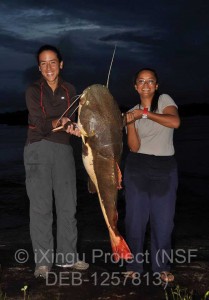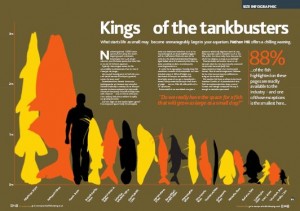Red Tailed Catfish, Phractocephalus hemioliopterus, are one of the true ‘big cats’ of the aquatic world. They are also readily available to buy, inexpensive, look cute when juvenile and have impressive colouring when adult. All of which makes them relatively popular as aquarium fish. But (and it’s a big but) if one of these catches your eye, are you sure you’re ready for what you’re going to end up with?
Baby red tailed catfish are known as ‘kittens’ which only adds to the ‘cute factor’. But how does your red tailed catfish kitten compare to the other sort of kitten commonly kept as a pet? Here’s where it gets interesting!
Red tailed catfish are generally imported when they are around 2″/5cm long (planetcatfish). When fully grown they can easily reach lengths of 53″/134cm. That’s over four feet long! A little maths tells us that this means they grow a little over 26 times the length they were at the time of import. Even if we’re being generous and say they grow a fair bit in the shop before being bought, it’s likely they are not much more than 5″/13cm when purchased. This would mean that the fish would grow about 10 times the length it was when purchased.




The Deep are key supporters of the Big Fish Campaign and fish like Gabriel are really important in helping people consider just how big fish can grow before buying one. Don’t be fooled by the myth that fish only grow to the size of their tank, check out our further reading section for more information on this. They think Gabriel’s not quite reached his full size yet so he’s definitely going to be a big guy! The Deep have told us that some of the red tailed catfish in their display are rescues, taken in from members of the public who were no longer able to accommodate them in their domestic aquariums.
Below are some adult red tailed catfish caught in the wild in Brazil during research for the iXingu Project. When you see the true size these fish should reach you can see why we think they’re one of the species best left in the wild and not kept in domestic aquariums. These wild caught red tailed catfish manage to make the adults shown above look like they’ve got some growing to do.


Please see the further reading section for more information on the important research work the iXingu Project team are undertaking.
The sort of kitten that most people are more familiar with are the little fluffies pictured below, domestic cat kittens. They start off quite small, like the little chap in the grass, then by the time they are ready to be sold they are about 10″/25cm long (head and body length) like those on the cushion and on the tiles (those are small tiles!). Then they get a little bigger in that sort of ‘teenage’ size like the sleepy fellow on the digi-box (that box is 12″/30cm long). Finally they are all grown up, about 18″/45cm long and ‘helping’ with the DIY. Again, a little maths tells us that if a kitten is about 10″/25cm when you buy it, it grows about 1.8 times the length it was when purchased.





Can you see where this is heading yet?
What would happen if Fluffy the kitten increased in size in the same way that a red tailed catfish kitten will? If you think it will ‘grow to the size of the tank’ you might want to read our article on this unfortunate myth.
Let’s assume that Fluffy was 10″/25cm long when you bought him. We said above that a red tailed catfish which was 5″/13cm when bought would grow to 10 times that length to become a fully grown adult. If we apply the same 10 times to Fluffy that makes him 250cm long when he’s fully grown. That’s a little over 8 feet, equivalent to just the head and body of one of these (the tail’s an extra few feet!) …



‘Zero’* lives in South Africa, he’s a wild lion and is being monitored as part of a conservation and small reserve management project.
Below is a smaller male, Luther (Zero and Lisa’s son), being checked over before being moved to a new area. Luther is smaller than Zero, so it gives a good idea of just how big Zero really is! Luther’s about 18 months old here, so he’s got a way to go yet, rather like the red tailed catfish in our second picture above.

And a close up of Luther’s paw being measured … it’s 5″/13cm across the pads. And that’s not fully grown yet.

Time for a bit of soul searching …
Would you buy Fluffy if you knew he was going to turn into Zero? It might sound like fun, after all, who else do you know that has a pet lion? But the realities of keeping a pet lion (apart from the legal issues!) would make it completely unrealistic for the vast majority of people. Yes, there are a very, very few who have the knowledge, time, money and space to do it successfully but we think you’ll agree this is not a pet for the average household.
Do you still think a red tailed catfish is a suitable fish for the average domestic aquarium? If you can provide the huge aquarium they need, and it needs to be huge (have a look at our article on stocking guides to see just how huge) then that’s brilliant and a great example to other would-be keepers of the real needs of these aquatic big cats. If you can’t provide a suitable environment for the full duration of the fish’s life, then you need to be realistic about whether or not you should buy it.
The ‘infographic’ below shows a red tailed catfish in comparison to a human. The red tailed catfish is the yellow one on the right of the human.
(Infographic reproduced by kind permission of Nathan Hill & Jeremy Gay of
Practical Fishkeeping Magazine, link to PDF for download at bottom of article)
Taking it a step further …
Over 75,000 red tailed catfish were exported from Peru in 2003 (UAKARI.org). Assuming today’s figures are still similar that’s a huge amount of fish. They won’t all be going to the UK, but it’s not unreasonable to estimate that the annual UK import numbers are in the hundreds, if not thousands.
Being conservative, several hundred ‘Fluffys’ will not be too hard to find a home for, but several hundred Zeros? Every year?
What if you do buy a ‘Fluffy’, what will you do with it when it grows into a Zero and you can’t keep it anymore? Many people think they will be able to sell their red tailed catfish. In reality though, there isn’t much of a market for second hand lions. There’s a good reason not many people actually want a fully grown lion. How about giving it to a zoo? There are a limited number of zoos in the UK, and most of them already have as many lions as they can accommodate. It might be possible for the UK zoos to take on one or two between them, but several hundred every year? That’s going to be impossible. And the same is true for red tailed catfish and public aquariums. The UK’s public aquariums are already overwhelmed with requests to rehome various big fish, they cannot take them all on.
The health issues must not be overlooked either. Without the right conditions Zero is likely to become ill, and possibly die. He needs lots of space, lots of food and he needs his home keeping clean (he makes a lot of mess!). Without enough space, enough food, clean living conditions he won’t live to his full lifespan. Many of us have seen pictures of big cats kept in terrible conditions, wasting away and confined in small cages in zoos that can’t cope with them. They feature in the news now and again, a rescue mission highlighting the plight of these beautiful animals being abused. A quick visit to Google turns up plenty of stories like this. Again, the same is true for red tailed catfish. Many die prematurely in captivity because they weren’t given the conditions they need to thrive, but these rarely if ever hit the headlines.
And the cost of keeping one? Jonny Rudd of Bristol Zoo calculated the approximate cost of keeping a red tailed catfish for the duration of its lifetime as part of an article for Practical Fishkeeping in support of The Big Fish Campaign. His estimate was over £100,000 (practicalfishkeeping.co.uk).
These aquatic big cats should not be underestimated, they are just as deserving of the right conditions as lions like Zero are.
Are you absolutely sure you’re able to go from this …


To this …?



Author: INJAF
Photographs and video: courtesy of Mats Petersson, Brigitte de Coriolis, Andieu, S Ofei-Kwatia, fishtanksandponds.co.uk, The Big Fish Campaign, Dr. Mark Sabaj Perez and the iXingu Project, and The Deep public aquarium.
Wikimedia Commons, Adult red tailed catfish by Monika Betley, (online) available at https://en.wikipedia.org/wiki/File:Phractocephalus_hemioliopterus-Dixi.jpg (accessed October 2012)
At INJAF we either use our own photos, get permission to reproduce them from the owner or use those available on a creative commons license as we are not in the habit of image theft. Unfortunately this means there aren’t that many images of baby or adult red tailed catfish available to us. We recommend you do a search of Google images for more photos of the true adult size of red tailed catfish, they are quite a thing to behold!
We owe a big thank you to Dr. Sabaj Perez, Alany Goncalves and Mariangeles Arce for giving us permission to use the iXingu photos, a fantastic opportunity to see wild caught red tailed catfish.
References and further reading
fishbase.org, Species Summary – Phractocephalus hemioliopterus Red Tailed Catfish, (online) available at https://www.fishbase.org/summary/speciessummary.php?id=6421 (accessed October 2012)
UAKARI.org, An industry analysis of the freshwater ornamental fishery with particular reference to the supply of brazilian freshwater ornamentals to the uk market, (online) available at https://www.uakari.org.br/index.php/UAKARI/article/viewFile/18/23. (accessed October 2012)
planetcatfish.com, Catfish of the Month – January 2000 – Red tailed Catfish Phractocephalus hemioliopterus (online) available at https://www.planetcatfish.com/cotm/cotm.php?article_id=77, (accessed October 2012)
seriouslyfish.com, Species profile – Phractocephalus hemioliopterus Red-tail Catfish (online) available at https://www.seriouslyfish.com/species/phractocephalus-hemioliopterus/ (accessed October 2012)
fishtanksandponds.co.uk, Fish Profiles – Phractocephalus hemioliopterus Red Tailed Catfish (online) available at https://www.fishtanksandponds.co.uk/galleries/photo-pages-fw-tropical/siluriformes/phractocephalus-hemioliopterus.html (accessed October 2012)
Practicalfishkeeping.co.uk, How much will this fish cost to keep in its lifetime? (online) available at https://www.practicalfishkeeping.co.uk/content.php?sid=4951 (accessed October 2012)
Further reading
Who’s to blame for the big fish problem?
Where do all those big fish keep going?
Bournemouth Aquarium appeals to exotic pet owners
Two catfish find new homes at Blue Planet Aquarium
How much will this fish cost to keep in its lifetime?
PDF of Tankbuster infographic
Freshwater Tankbusters courtesy of Practical Fishkeeping Magazine
INJAF has some further information on
The Big Fish Campaign (also on Facebook and Twitter)
Tankbusters
Do fish grow to the size of their tank?
Understanding fish stocking guides
The iXingu Project
The iXingu Project is “Collaborative Research: Baseline Survey of the Lower Xingu River Rapids, Brazil: a Highly Diverse, Globally Unique, and Immediately Imperiled Ecosystem”. The project is researching the area around the Rio Xingu in Brazil, an area which is under serious threat from the construction of the Belo Monte Dam. In fishkeeping circles the area is best known as the natural home of the ever popular ‘zebra plec’, Hypancistrus zebra. Unfortunately the area has hit the headlines for very different reasons with the controversy surrounding the construction of the Belo Monte Dam.
The iXingu Project is best explained by those involved, so we’ll hand you over to the experts that are Julian Dignall, Dr. Mark Sabaj Perez and Dr. Nathan K. Lujan.
The PlanetXingu Project, Part 1 • An Introduction to the project
The PlanetXingu Project, Part 2 • Who is Mark Henry Sabaj Pérez?
The PlanetXingu Project, Part 3 • Project FAQs
The PlanetXingu Project, Part 4 • Who is Nathan Lujan?
The PlanetXingu Project, Part 5 • We did it
iXingu has a Facebook group with further photos and updates.
More information on the flora and fauna of Brazil
ARKive.org – Discover Brazil
* Zero
Zero is part of a conservation project in South Africa. He’s a wild lion and lives on a reserve with his pride, and others. His lady friend in the photo with him is called Lisa. They are also mum and dad to Luther, among others. Zero is so called because he was the first of the project to be tagged, hence his tag number is 0. Numbers of wild lions are falling as hunting and poaching take their toll on the wild populations. It’s important to protect and study them as they play a pivotal role in the bush hierarchy and ecology. They are an apex predator and without them the food chain and species balance would be badly damaged. Understanding how the animals live and work together helps researchers better understand how they are affected by man’s actions, and helps to safeguard their future a little more.





